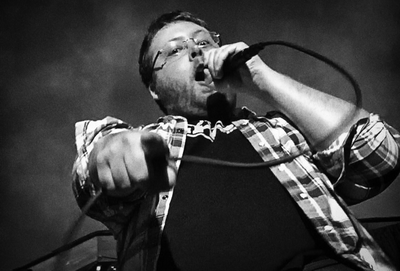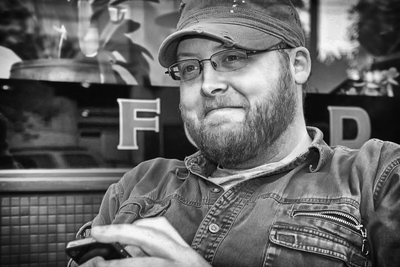Matt Lefferts, our Lead Animator, sat down recently with me to talk about how he got into the game industry. We also learn which career path he might have taken in an alternate universe. —Brian Ward

Can you give us a little background about how you got into the industry?
I, as a kid, had a pretty good inkling of what I wanted to do with my life. Around the age of 6 or so, I was very into The Muppets Show and things like Fraggle Rock. Really just in love with The Jim Henson Company and Calvin and Hobbes. Those are really the two biggest pillars of my childhood iconography. Around that time, I just kind of had a sense that when I grow up I want to do something like this. I want to do monster makeup, or “muppetry,” or animatronics. And that was the first idea of a career that I had at a pretty early age that was just very appealing. It sounded cool. It sounded like the kind of thing that I did as a kid: I played with action figures and wanted to grow up and pretty much keep doing that.
As technology kept changing, and Pixar came out with Toy Story, and CG started to get more prominent in the visual effects industry, animatronics died away. So I started looking at what would essentially be the next logical step into visual effects – and CG animation is essentially the same thing I wanted to do.
I ended up going to college for two things, double majoring in animation and film. There just came a point in that time when I didn’t like the path that life was leading with film. It was surrounded by some very typical pretentious film students, and was an atmosphere that I despised, so I bumped my double major down to a minor and focused on animation for games and game development. I went to the Savannah College of Art and Design for that, graduated in 2006.
In 2005, I started freelancing while I was in school.
What kinds of projects?
I had a friend who graduated earlier than I did and she got a job right out of college at a small games studio in Atlanta, Georgia. And she was the only artist on the team and she needed some help so she contacted me. I did a couple of assets – well outside of my wheelhouse – this was modeling and texture work, which I am not that guy. It involved a little bit of animation as well.
That was my first real break into the industry. It was immediately about connections. I spent about two years freelancing. A year in college, and a year after college. I was really green and I ended up delivering on a project that I didn’t get paid for. So I got screwed over, which as a freelance artist, is something you will absolutely go through and I ended up having to move back home to Connecticut from Savannah, Georgia.
And I lived in Connecticut for about a year. I was sending out resumes every day. Thankfully, my parents were cool with it. My dad and I had a discussion about how “the time to work in retail” at places like Best Buy “has ended.” It was great, because I was trying to tell him that, right at the same time that he told me that. And I was like: okay, we’re on the same page.
So I started working at Flagship and I pushed myself really hard and was always trying to come up with new game ideas. In talking to Marsh and Travis about me back then, they I think viewed me as the guy who pitched ideas that were outlandish and were never going to happen. But I know that I had a lot of enthusiasm for it. I was trying to leave my mark on the project – because I was coming into something that I didn’t start. And there was a lot of animation work that I was trying to improve or give a unique quality to some of the different races. This was when we were working on the beta development of Mythos.
I was about four months into the project and it shut down – and I was out of a job! I had just moved to the city. I didn’t even really know anyone yet. I had enough money to either buy a plane ticket home or pay rent one more time and stick around. In the wake of all that, when we were shut down, we knew immediately that we were going to form Runic. We didn’t know it would be called that. That took time. I think I still have the incredible email chain that went on for days and days between fifteen people about what we should call the company.
What’s your process for animations? How do you come up with realistic animations?
There are several layers to that kind of process. I always try to get involved to a little degree in the concepting phase. I don’t want to direct anything about it, because that’s not my job. But I do like to look at it and say, “So what are we thinking about the range of motion for this limb? Does it bend this way? What’s the personality of the character?” I always definitely encourage our concept team to draw the character with some kind of distinct quality of emotion or personality. That just lends itself to getting into the head of the character. That’s really what it comes down to: getting into the head of the character. When it’s a clear design and well-modeled and well-textured, there’s something really special about that kind of character. It all just clicks in a way artistically that makes it feel alive. I instantly can see it and can just say, “I know what this guy is supposed to do.” I feel the personality out.
So you almost come up with a backstory for the character?
Yeah, absolutely. I took a lot of classes about that kind of thing in college: How would this character handle being alone in a room with a baby? That’s a classic question. It’s about the psychology of the character.
Maybe it’s part of my natural inborn personality, or maybe it’s my training as an animator, but I’ve spent a lot of time just watching people move, on the street, when I’m out for drinks with people. It’s really fascinating. I really like, from time to time, putting headphones in to kind of block out other sounds and just watch the way people use their hands and body language to communicate and I’ll try to mimic that so that I can understand.
Are there other animators whom you admire?
Yeah, absolutely. A lot of them are actually good friends of mine. I have colleagues out here in Seattle. Christine Phelan is one of them. She’s a great friend and an incredible animator, the kind of person that it’s just frustrating to look at her work because I’m never going to get that good and she’s so frickin’ talented. But as frustrating as that is, it’s really inspiring, and that’s really what it’s supposed to be. It’s supposed to be a swift kick in the pants to be better at what I do.
I’m not purely inspired by other animators though. I would say that Bill Waterson is one of the best inspirations I’ve ever had – and Jim Henson. The way the Skeksis move in The Dark Crystal. Amazing. Totally amazing. You forget that they’re not real – and that holds up until today. Bill Waterson – his drawings for Calvin and Hobbes are just flawless. Those poses, as an animator, are just perfect. In addition to that, I’m a huge Marvel fan, which I think really lends itself to the work that I do with heroes and monsters and things – that kind of posing from comics.
Because it’s all action-based?
Yeah, and you get the sense of what a hero figure can be. I draw from a lot of people like Steve Epting and Adi Granov. David Aja (as the artist) and Matt Fraction (as the writer), they are working on a few books together. Right now, they are working on Hawkeye and before they were working on The Immortal Iron Fist, which that one really just stood out for me. Those poses again, he has as much more realistic style, but he captures flawless frames. You could translate it to movie shots beautifully. And it just holds the personality of the character incredibly.
The way they carry themselves, the difference between goofing around and then suddenly getting ambushed by a pack of ninjas or something. Just the way that a character can stand with slumped shoulders, but then suddenly go into this heroic thing. It could be easily cheesy, but he has this masterful way of making it cool.
Would you say there is a particular emotional state that you like to animate for more? Happy, sad, ambivalent? Is there something in particular that you like to do more?
As far as particular states go, I’m not sure. I don’t think I have a proclivity one way or another, except that I really like when a character does have an emotional state. A lot of the time, we have to animate for just general circumstances, which could be many emotional states. We will do good work, and we’ll get good stuff out of it, but whenever there’s more specifics to it, there’s something inherently interesting because it sparks new ideas.
One of the longest animations that I ever did was actually on Torchlight II, and it was one which most people probably never even saw. It was the Claptrap from Borderlands that we did as an Easter egg in Act III after the Bloatfang fight, which is tucked away down in the bottom of the screen and players have to find their way down there. For those that did, I certainly hope they watched the animation. I have to believe that a few out there did. In most cases, you just run over and click on him. It was a really long, dialog-synced, sequence of animation, which I hadn’t done in a long time – most of what we do are simple cycles and things. Doing actual dialog acting was something that I needed to dive into again, and it took a long time, but it was super rewarding, and I still love that animation.
I find as an animator – and I know a lot of other animators do this too – you put an intense amount of detail into something that only another animator will notice. But animation is deceptively crucial to video games. It doesn’t always get a lot of attention – most of the time it doesn’t get a lot of attention – but it’s the kind of thing that when it’s there it brings a game to an entirely new level without having to be the focus. When it’s not there, as a gamer and as an audience member, you kind of feel like something is missing.

What drives you? You get very excited about the process in general. What inspires you to be an animator, to be in the game industry, and to create all this stuff?
I don’t think I had a choice. My imagination has always been really strong. Growing up, I watched a crap ton of TV as a kid, which everyone told me would rot my brain. But I absorbed story structure, characters, ideas, plot points, all the different encompassing factors of that media. My imagination runs wild. As a kid, I created a superhero of my own and it’s a story I’ve been writing my entire life – it’s my genuine life’s work.
When I see a game in my head, it’s a very clear picture. It’s usually typically a small vignetted moment of gameplay. But I can see the level, and the lighting, and the texture quality. What the character is and how they’re standing, and how they’re moving, and small elements of gameplay. When I get little flashes like that in my head, I can’t ignore them – they just keep coming back – so I have to write them down. Working in the game industry and working as an animator is an excellent creative outlet. It lets off the pressure because I’ve got ideas kicking around all the time.
You get burned out. But you just have to find a new source of creativity. You have no idea where it’s going to come from. I find music does it just as much as anything else.
Of course, the only thing I only would have done with my life, I think, outside of being an animator – which was highly dependent on my ability to do math, hence being an animator – would have been astrophysics.
Really?
Yeah. My dad used to take me out as a kid in a blanket – I’m talking like 3 or 4 – to go look at the stars. And he would tell me the names of constellations and their relationships to the seasons. Everything we could absorb. I’ve never let go of that moment, those memories. That entranced me. I have spent my entire life learning about space since then.
With something like Cosmos that just aired – holy cow! That was the first television show since the original Cosmos that I felt was worthy of everyone’s attention.
Are there any games you’re looking forward to?
Shadows of Mordor, the new Lord of the Rings one that is kind of Assassin’s Creed-esque. I’m very excited about that one. It’s got a lot of cool things going on.
Monster Hunter 4 Ultimate. Holy cow! I bought a 3DS because of Monster Hunter 3 Ultimate. That was my first entrance into the Monster Hunter world. That is one of my favorite game series of all time. It’s amazing. I kind of feel like it’s an animator’s game because those creatures come to life in a way that very few other games achieve.
If you had to pick one game. This would be the only game you could take with you.
You know. I have no idea. I would love to have a good answer for that. Number one, I’m sure I would get sick of anything. Number two, so many things jump to mind that it’s hard to leave – okay, what I will say is that I have a favorite game series. There are lots of games in it, and some of them are truly craptastic, but it’s the best narrative story, narrative structure of a game series that I’ve ever encountered.
It’s the Legacy of Kain series, the Soul Reaver series. That is my favorite story of any game. It’s completely convoluted, it’s full of plot holes, it’s all about time travel, and vampires, and demons, but in a good way – not the sparkly crap way.
I remember as a kid with my Dreamcast getting a copy of Legacy of Kain: Soul Reaver. I had Blood Omen, but I didn’t realize they were connected until well into it. But it was the writing and the dialog was smarter than any game I had seen. Just because I was a kid, it didn’t treat me like I wasn’t going to understand it. That was one of the things that transcended crappy gameplay in a few of the later iterations of the game. I went through all of those hardships because the story was so good! That would be my answer.
Any particular advice for anyone who would want to be a game developer or animator?
There was a defining moment in college for me. And I don’t know if it happens at that point or not for everybody, but it did for me. When I clearly saw the distinction between those of us who were there sixteen hours a day in the labs. Mine was Montgomery Hall, our computer lab down in Savannah, Georgia. Ten, twelve, sixteen hour days just working really hard on animations – with other people. And you ended up kind of seeing the same people night after night.
The distinction was: There were those of us who wanted to make games and there were those that were there in the major who wanted to play games. You have to figure out which side of that you’re on. I’m still friends with a lot of people that I went to school with – they’re great people – but I see them struggle because they never took it seriously. It’s the only skill they developed, but they weren’t into it enough to really follow through. I am one of the most exceptionally lazy people I know, but you have to find the thing that you’re passionate about. If you’re struggling with it, it doesn’t mean you’re not capable of doing it, but find an avenue that you do love. I made sure that I have a job that is as close to playing with action figures as humanly possible – aside from playing with action figures. If I could get paid to do that, I might. But having a digital collection of characters is like having a toy box. I love getting a new character.
This article is part of a series of Q&A sessions with the Runic dev team. Be sure to check out our previous installment — an interview with Mike Fisher.
